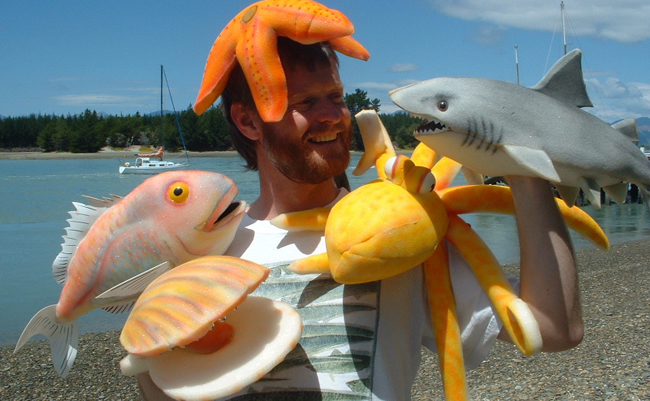
New Zealand Marine Studies Centre (NZMSC) Educator Richard de Hamel (who is based in Nelson) has employed 'Shag' the puppet to engage primary school audiences in activities.
For more than 20 years, the New Zealand Marine Studies Centre (NZMSC) has played a key role connecting communities with their local marine environment through a wide range of outreach and education programmes and resources.
Currently closed due to the COVID-19 lockdown and with no access to the Portobello laboratory, local environment or animals as teaching tools, the NZMSC has being innovative in developing online resources to continue inspiring and engaging students in learning about the ocean environment.
In the months prior to lockdown, the Centre had proactively established four live webcams that keep a constant eye on the seahorse tank, touch tank, fish tank (with loads of kōura), and from the Portobello Marine Lab Wharf.
"Research suggests STEM identity is established between the ages of 10 and 12 years, so providing relevant science activities for both primary and secondary students is important to increase the number of students following study pathways in science."
These webcams can be accessed here, and the NZMSC Director Sally Carson asks that if anyone spots any interesting behaviour like seahorses mating, to please let the Centre know!
With a predominant focus on supporting educational programmes at both secondary and primary levels however, during lockdown the Centre's educators have been working hard to develop online resources from the comforts of home.
From his kitchen, Educator Steve Cutler has created a series of videos under the theme 'Is there an ocean in the house?' which support the Centre's Science Extension and Enrichment programme for secondary students.
Meanwhile the Centre's Nelson-based Educator Richard de Hamel has employed 'Shag' the puppet to engage primary audiences in activities, and through newsletters and social media the NZMSC is highlighting the wide range of resources available on its website.
Ms Carson says the skills required to develop online resources are very different to those used in the Centre's hands-on learning, but notes that as the educators are such great communicators they have being incredibly creative and willing to give anything a go.
“Developing these resources has been critical for continuing the Centre's work, and to maintain our contracts with the Ministry of Education,” Ms Carson says.
“Research suggests STEM identity is established between the ages of 10 and 12 years, so providing relevant science activities for both primary and secondary students is important to increase the number of students following study pathways in science. Teachers also enjoy learning and appreciate the Centre's resources about relevant real-world issues.”
Ms Carson says the development of these online resources will also be used in conjunction with future 'business as usual' on-site learning, and also to extend the Centre's reach to North Island schools and further into the Pacific such as Tonga where it is building relationships.
"COVID-19 has highlighted the growing prominence of science in society and projects like these highlight the crucial role the Centre plays in both our community and more broadly with our connection to the ocean."
In the interim however, not having school students at Portobello has resulted in a loss of income for the Centre so the seeking of other funding opportunities continues.
The absence of students currently attending the NZMSC due to the pandemic has added additional financial strain for the Centre which for a number of years has run on a year-to-year basis. The NZMSC is now exploring ways to include donations from the public as well as philanthropic and sponsorship partner opportunities.
The NZMSC was set up in 1997 to support Otago's growing marine science programme, which since then has been growing in strength since with research now taking place from Antarctica to the Pacific.
The Marine Science Department is taking lead roles in recently announced Antarctic Science Platform projects, including a six-year project that will focus on species distribution in the biologically productive Ross Sea region which includes the world's largest Marine Protected Area.
With the ever-growing awareness on key challenges like climate change, communicating the science of coastal regions as one the most diverse ecosystems on the planet is increasing in prominence especially with its links to a wide range of human and economic activities.
Closer to home the NZMSC flagship citizen science project MM2 (Marine Metre Squared) has also turned to online delivery, but with alert levels dropping it is an ideal time to engage with your seashore neighbours and participate with your family (visit www.mm2.net.nz to get involved).
The more recently developed Shark Spy citizen platform is also encouraging anyone who spots egg cases on their beach walks to log their sightings on iNaturalist.
“COVID-19 has highlighted the growing prominence of science in society and projects like these highlight the crucial role the Centre plays in both our community and more broadly with our connection to the ocean.”
